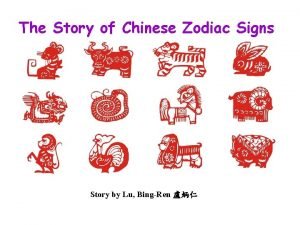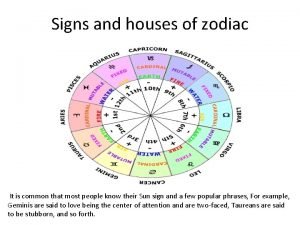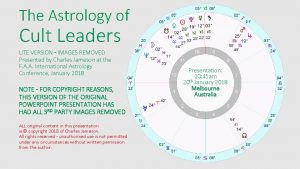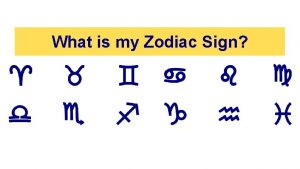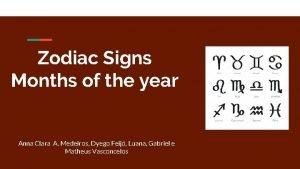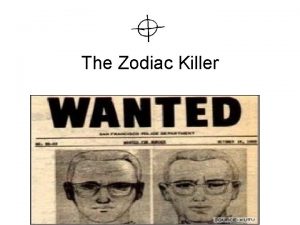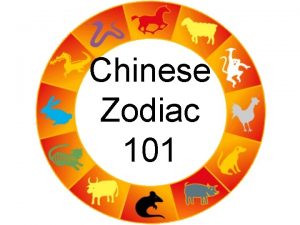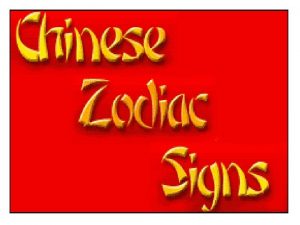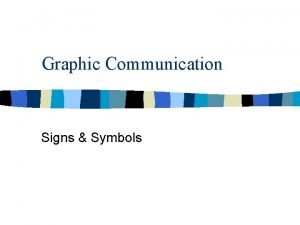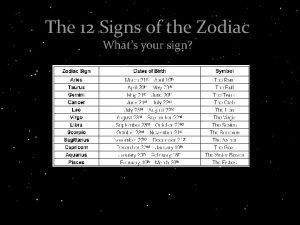SIGNS OF THE ZODIAC 2 nd GE L













- Slides: 13

SIGNS OF THE ZODIAC 2 nd GE. L. OF EXEDOROS PROJECT: THE HISTORY OF THE ZODIAC IN THE ANCIENT GREEK MYTHOLOGY. PIC: THE SUN

ARIES • In Greek mythology, the constellation of Aries represents the golden ram that rescued Phrixos, taking him to the land of Colchis. Phrixos sacrificed the ram to the gods and hung its skin in a temple, where it was known as the Golden Fleece. PIC: STARBUST

TAUROUS In Greek mythology, Taurus was identified with Zeus, who assumed the form of a magnificent white bull to abduct Europa, a legendary Phoenician princess. In illustrations, only the front portion of this constellation are depicted; in Greek mythology this was sometimes explained as Taurus being partly submerged as he carried Europa out to sea. Greek mythographer Acusilaus marks the bull Taurus as the same that formed the myth of the Cretan Bull, one of The Twelve Labors of Heracles. PIC: EYROPA , TIZIANO

GEMINI • Gemini was associated with the myth of Castor and Pollux, collectively known as the Dioscuri. One myth of these twins concerns cattle theft, and may be connected to earlier myths that described the Milky Way as a herd of dairy cows. On star maps, the twins are usually viewed as leaning away from the Milky Way, but are sometimes depicted with one of the twins residing in the Milky Way, and the other outside it, a situation making it appear that one of the twins is stealing the cattle, and the other is observing. When Castor died because he was mortal, that Pollux begged his father Jupiter to give Castor immortality and he did, by uniting them together in the heavens. PIC: GEMINI

CANCER • Cancer the crab, plays a minor role in the Twelve Labors of Hercules. While Hercules was busy fighting the multiheaded monster, Hydra, the goddess Hera, who did not like Hercules, sent the Crab to distract him. Cancer grabbed onto the hero's toe with its claws, but barely breaking the rhythm of his great battle with Hydra, Hercules crushed the crab with his foot. Hera, grateful for the little crustacean's heroic but pitiful effort, gave it a place in the sky; but none of its stars were bright because the crab had failed to accomplish its given task. PIC: Cancer Crab, David Shankbone

LEON • In Greek mythology associated with the lion of Nemea, which is the first labor of Hercules. He lived in the forest of Nemea and cause great damage. His skin was impassable, so the hero to kill, had to drown. All atlases of the sky showing the hero wearing or holding the lion. Because the lion was immortal nature, the gods brought back to life as a constellation of the sky PIC: STAR AE AURIGAE

VIRGO • The Greeks and Romans associated this constellation with their goddess of wheat, Demeter-Ceres, who, in early versions of the myth, was the virgin mother of Persephone was the Queen of the Underworld, the korē (or young maiden), in later Classical myths, a daughter of Demeter and Zeus in Greek mythology. In the Olympian version, she also becomes the consort of Hades when he becomes the deity that governs the underworld. The figure of Persephone is well-known today. Her story has great emotional power: an innocent maiden, a mother's grief over her abduction, and great joy after her daughter is returned. It is also cited frequently as a paradigm of myths that explain natural processes, with the descent and return of the goddess bringing about the change of seasons. PIC: VIRGO

SCORPIUS • In Greek Mythology the myths associated with Scorpio almost invariably also contain a reference to Orion. According to one of these myths it is written that Orion boasted to goddess Artemis and her mother, Leto, that he would kill every animal on the earth. Although Artemis was known to be a hunter herself she offered protection to all creatures. Artemis and her mother Leto sent a scorpion to deal with Orion. The pair battled and the contest was apparently a lively one that caught the attention of the king of the gods Zeus, who later raised the scorpion to heaven and afterwards, at the request of Artemis, did the same for Orion to serve as a reminder for mortals to curb their excessive pride. PIC: WHIRLPOOL GALAXY

SAGGITARIUS • In Greek mythology, Sagittarius is identified as a centaur, half human, half horse. In some legends, the Centaur Chiron was the son of Philyra and Saturn, who was said to have changed himself into a horse to escape his jealous wife, Rhea. Chiron was eventually immortalised in the constellation of Centaurus, or in some version, Sagittarius. PIC: SAGGITARIUS

CAPRICORNUS • This constellation is sometimes identified as Amalthea, the goat that suckled the infant Zeus after his mother Rhea saved him from being devoured by his father Cronos (in Greek mythology). The goat's broken horn was transformed into the cornucopia or horn of plenty. Some ancient sources claim that this derives from the sun "taking nourishment" while in the constellation, in preparation for its climb back northward. However, the constellation is more often depicted as a goat with a fish's tail. One myth says that when the goat-god Pan was attacked by the monster Typhon, he dove into the Nile; the parts above the water remained a goat, but those under the water transformed into a fish. In Sumer, the constellation was associated with the god Enki (Babylonian Ea), who brought culture out of the sea to humankind. PIC: CAPRICORNUS

AQUARIUS • Aquarius is sometimes identified with Ganymede, a beautiful youth in Greek mythology with whom Zeus fell in love and, in the disguise of an eagle (represented by the constellation Aquila) carried off to Olympus to be cup-bearer to the gods. The constellation of Crater is sometimes identified as his cup. • Aquarius may also, together with the constellation Pegasus, be part of the origin of the myth of the Mares of Diomedes which forms one of The Twelve Labours of Heracles. Its association with pouring out rivers, and the nearby constellation of Capricornus, may be the source of the myth of the Augean stable, which forms another of the labors PIC: AQUARIUS

PISCES • According to one Greek myth, Pisces represents the fish into which Aphrodite and her son Eros transformed in order to escape the fire god Typhon; they are tied together with a cord on their tails, to make sure they do not lose one another. Alternatively, the twin fishes were placed in the heavens in honor of their heroic deed of saving Aphrodite and Eros from Typhon on the river Euphrates. PIC: GALAXY-NGC 1232

Thank you very much for watching our presentation patiently!
 Chinese zodiac arrangement
Chinese zodiac arrangement Capricorn house
Capricorn house Marshall applewhite birth chart
Marshall applewhite birth chart Sign shapes meaning
Sign shapes meaning Zodiac for january 20
Zodiac for january 20 Irig 106 chapter 10
Irig 106 chapter 10 Skak
Skak Grendel chapter 7 summary
Grendel chapter 7 summary Zodiac 360 fastroller
Zodiac 360 fastroller Anna zodiac sign
Anna zodiac sign Zodiac killer background
Zodiac killer background Zodiac data systems
Zodiac data systems Natural and conventional signs in semantics
Natural and conventional signs in semantics The color of a recreation area sign is ______________.
The color of a recreation area sign is ______________.
